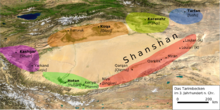Shorchuk
Shorchuk or Schortschuk ( Uighur شورچۇق Xorquⱪ , Chinese 錫 格 沁 地面 寺院 / 锡 格 沁 地面 寺院 , Pinyin Xīgéqìn dìmiàn sìyuàn ) is a complex of temple ruins in the Yanqi Autonomous County of the Hui , about 25–30 km southwest of the seat of the county government, the seat of the ancient Yanqi , seat of the ancient Yanqi community Kingdom of Karashahr , in the Uyghur Autonomous Region of Xinjiang in the west of the People's Republic of China , on the northeastern edge of the Tarim Basin .
history
Shorchuk appears for the first time in Chinese sources from the time of the Han dynasty under the name Chinese 焉耆 , Pinyin Yanqi . This is how it appears in AD 94 when it was defeated and conquered by China in the course of the reconquest of the Tarim Basin. At that time Shorchuk was the center of a kingdom whose domain, according to the testimony of the Chronicles of the Three Kingdoms, extended to Korla in the south . The Chinese pilgrim Faxian .. That Qigexing Buddhist Temple Ruins around 400 AD visited reported that here at this time 4000 monks of the Hinayana - Buddhism were staying. Also Xuanzang who lived in the seventh century AD, reports still 10 Buddhist monasteries and 2,000 monks. In 719 the Chinese Tang dynasty established a garrison in Shorchuk as well as in Kuqa , Kashgar and Hotan .
Shorchuk is also of great importance in archaeological terms. There are ruins of larger temples and some cave temples. In them, individual remains of wall paintings, but above all numerous sculptures, were discovered, including both individual figures and friezes. The sculpture from Shorchuk shows a clear and extraordinarily characteristic physiognomy, which is particularly recognizable in the strongly bulging faces.
literature
- Albert Grünwedel : Old Buddhist cult sites in Chinese Turkistan, report on archaeological work from 1906 to 1907 near Kucha, Qarašahr and in the Turfan oasis . Berlin, 1912.
- Zaturpanskij, Choros (i.e. A. v. Le Coq): Routes and results of the German Turfan expeditions , Orientalisches Archiv 3, 1912, pp. 116-127.
- Marianne Yaldız : Archeology and Art History of Sino-Central Asia (Xinjiang) . Leiden, 1987.
Web links
Coordinates: 41 ° 56 ' N , 86 ° 20' E

